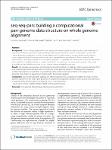seq-seq-pan: building a computational pan-genome data structure on whole genome alignment
Jandrasits, Christine
Dabrowski, Piotr Wojtek
Fuchs, Stephan
Renard, Bernhard Y.
Background: The increasing application of next generation sequencing technologies has led to the availability of thousands of reference genomes, often providing multiple genomes for the same or closely related species. The current approach to represent a species or a population with a single reference sequence and a set of variations cannot represent their full diversity and introduces bias towards the chosen reference. There is a need for the representation of multiple sequences in a composite way that is compatible with existing data sources for annotation and suitable for established sequence analysis methods. At the same time, this representation needs to be easily accessible and extendable to account for the constant change of available genomes. Results: We introduce seq-seq-pan, a framework that provides methods for adding or removing new genomes from a set of aligned genomes and uses these to construct a whole genome alignment. Throughout the sequential workflow the alignment is optimized for generating a representative linear presentation of the aligned set of genomes, that enables its usage for annotation and in downstream analyses. Conclusions: By providing dynamic updates and optimized processing, our approach enables the usage of whole genome alignment in the field of pan-genomics. In addition, the sequential workflow can be used as a fast alternative to existing whole genome aligners for aligning closely related genomes. seq-seq-pan is freely available at https://gitlab.com/rki_bioinformatics
Dateien zu dieser Publikation
Keine Lizenzangabe

